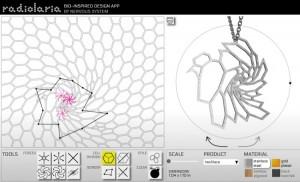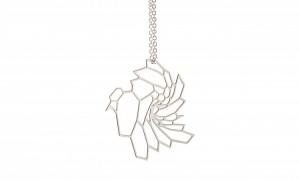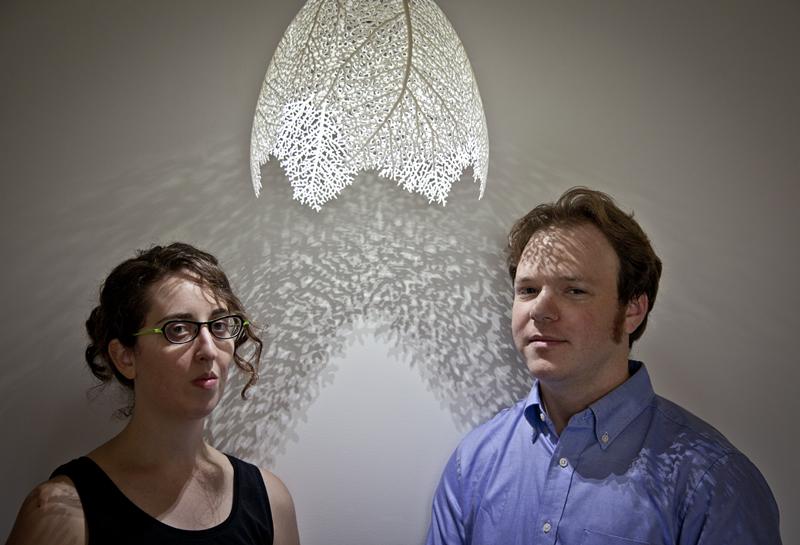Jessica Rosenkrantz and Jesse Louis-Rosenberg founded their digital design studio, Nervous System, back in 2007, and their Radiolaria is a co-creation app built alongside their 3D printed designs from their Cell Cycle and Kinematics apps.
 Nervous System recently made a splash with their 3D printed Kinematics Dress, and the overall process includes a number of different fashion items such as bodices and belts. The Kinematic Cloth from which the dress was created consisted of some 2,279 triangular panels interconnected by 3,316 “hinges,” and each piece is connected to the other to allow for movement and flow very like fabric. It’s an impressive piece of design, so much so in fact that NYC’s Museum of Modern Art acquired it for their permanent collection.
Nervous System recently made a splash with their 3D printed Kinematics Dress, and the overall process includes a number of different fashion items such as bodices and belts. The Kinematic Cloth from which the dress was created consisted of some 2,279 triangular panels interconnected by 3,316 “hinges,” and each piece is connected to the other to allow for movement and flow very like fabric. It’s an impressive piece of design, so much so in fact that NYC’s Museum of Modern Art acquired it for their permanent collection.
The Radiolaria app was inspired by microscopic cellular structures, and it allows designers to develop their own bio-inspired patterns by experimenting with a physics simulation of springs. The web app lets users of various skill sculpt patterns by “applying forces and subdividing cells, morphing a hexagonal mesh into intricate patterns which materialize as jewelry or decorative objects.”
Rosenkrantz and Louis-Rosenberg, both MIT graduates, call their Nervous System studio and the associated apps “generative design…that works at the intersection of science, art, and technology.”
The pair say their Radiolaria process employs computer simulation techniques to generate designs and products suitable for digital fabrication like art, jewelry, and housewares. The full app debuted in 2012 after having emerged as an idea and “processing applet” in 2007.
![]() Radiolaria in nature are protozoa that produce intricate mineral skeletons which generally feature a central capsule dividing the cell into the inner and outer portions of endoplasm and ectoplasm. Found throughout the ocean, the skeletal remains of radiolaria make up a significant portion of the ocean floor as siliceous ooze.
Radiolaria in nature are protozoa that produce intricate mineral skeletons which generally feature a central capsule dividing the cell into the inner and outer portions of endoplasm and ectoplasm. Found throughout the ocean, the skeletal remains of radiolaria make up a significant portion of the ocean floor as siliceous ooze.
And the Nervous System version of these creatures is an apt metaphor indeed for their Radiolaria creations.
“Formally, we are attracted to complex and unconventional geometries,” say the pair. “Our inspirations are grounded in the natural forms and corresponding processes which construct the world around us. From coral aggregations to interference patterns, a study of natural phenomena is an essential ingredient to our design process.”
Nervous System says that, rather than designing a specific form, they’ve built a system that can result in “a myriad of distinct creations.” Their system is interactive and changes specific variables and physical inputs to create a final product with no definitive result, but instead the many designs which are built to allow for mass customization.
of distinct creations.” Their system is interactive and changes specific variables and physical inputs to create a final product with no definitive result, but instead the many designs which are built to allow for mass customization.
The Radiolaria app lets a user build bio-inspired patterns through a physics simulation for sculpting patterns by applying “forces” and subdividing cells. The app allows for the morphing of a hexagonal mesh into intricate patterns which can then be output as jewelry or decorative objects.
 The interface itself is relatively simple and straightforward, and it allows a user to build objects with the process from approximately 2″ x 2″ in size to approximately 9″ x 9″. There are four modes — for creating necklaces, earrings, trivets/coasters, and art objects — which can be output in various metals and other materials like plywood and even felt.
The interface itself is relatively simple and straightforward, and it allows a user to build objects with the process from approximately 2″ x 2″ in size to approximately 9″ x 9″. There are four modes — for creating necklaces, earrings, trivets/coasters, and art objects — which can be output in various metals and other materials like plywood and even felt.
What do you think of this app from design studio Nervous System? Let us know in the Radiolaria forum thread on 3DPB.com.
Subscribe to Our Email Newsletter
Stay up-to-date on all the latest news from the 3D printing industry and receive information and offers from third party vendors.
You May Also Like
NSF Awards Kentucky $1M for Advanced Manufacturing
The National Science Foundation has awarded a $1 million grant to the University of Louisville for the Advancing Manufacturing and Building Construction Technologies (NSF AMT) project. This initiative is part...
3D Printing News Briefs, May 11, 2024: 3D Printed Stent, Tower, Sculptures, & More
We’re starting off with medical research in today’s 3D Printing News Briefs, as researchers in Korea used CT images and 3D printing to fabricate an educational simulator for a mastoidectomy....
3D Printing Unpeeled: Wind Turbines, Probiotics and Lenses
TPI Composites, ORNL and Ingersoll Rand are working to make wind turbine tooling segments that can be 18.3 meters long. These elements also include resistive wires that help keep the...
Tethon 3D Releases Cost-effective Bioprinter
Tethon 3D, known for its ceramic-loaded DLP materials, custom resins, and DLP 3D printers, has recently released a bioprinter. Vat polymerization printers like DLP systems have been widely used by...


































